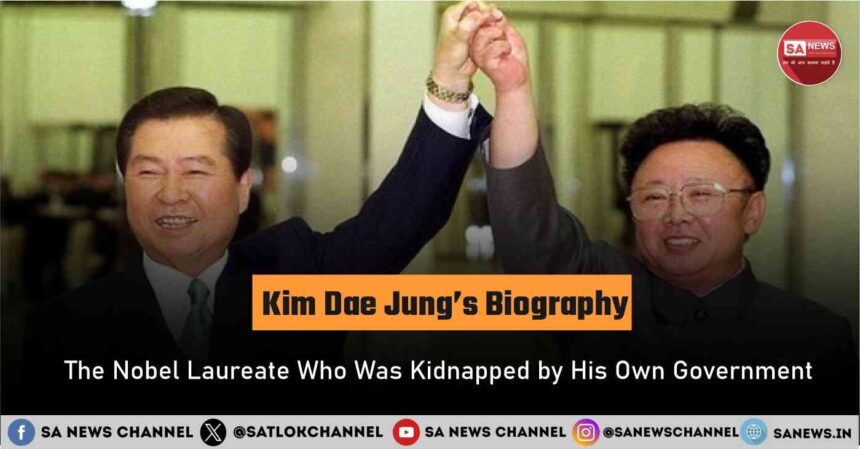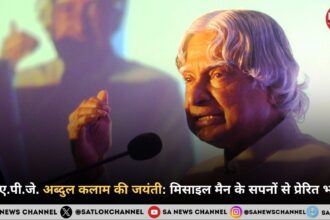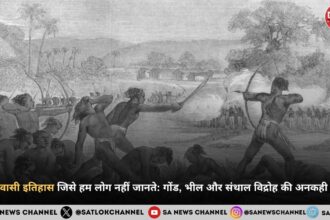When you picture a Nobel Peace Prize laureate, you might imagine a revered statesperson, an individual whose life was dedicated to diplomacy and peace-building from a position of influence. But the story of South Korea’s Kim Dae Jung shatters that conventional image. Before he became president and a global icon for peace, he was a dissident who survived five assassination attempts, kidnapping by his own government’s secret service, and a death sentence.
- A Brief Introduction of Kim Dae Jung
- Kim’s Early Life and Formative Years
- Kim Dae Jung’s Educational Journey
- His Inclination towards Journalism
- The Near Death Experience which changed everything
- Kim Dae Jung’s Political Awakening and Early Career
- Kim’s Marriage and Partnership with Lee Hee Ho
- The Struggle Against Authoritarianism
- The First Assasination Attempt: A Fight Against Tyranny
- The Yushin Era and International Advocacy
- The Tokyo Kidnapping: A Brush with Death
- The Democracy Movement and Continued Persecution
- Exile and International Recognition
- Presidential Campaigns and Democratic Transition
- The Sunshine Policy: A Vision for Peace
- Challenges and Criticisms of the Sunshine Policy
- A Legacy of Fortitude
- Pursuit of Life: Finding the Meaning
His journey from a death row inmate to the presidential Blue House is one of modern history’s most remarkable stories of resilience. In this article, we’ll walk-through the biography of the man often called the “Nelson Mandela of Asia.”
A Brief Introduction of Kim Dae Jung
Kim Dae-jung, born in 1924, is often regarded as the greatest president South Korea has ever had. He was awarded the Nobel Peace Prize in 2000 for his efforts in bringing democracy to South Korea and improving inter-Korean relations.
He was openly against South Korea’s authoritarian regimes for decades and faced many persecutions for it, such as imprisonment, house arrest, kidnapping attempts, and even a death sentence! Thankfully, that sentence was later commuted.
His courageous and resilient fight for democracy earned him the title of the “Nelson Mandela of Asia”, and just like that, he finally won the presidency of South Korea in 1997 which changed the nation forever, for the better.

He had a clear moral principle, and it was evident in how he opened up to Japan, Kim Jong-il, and how he approached Vietnam. We’ll explore the entire timeline of his remarkable life in this article, so keep reading!
Kim’s Early Life and Formative Years
Kim Dae-jung was born on January 8, 1924, in a quiet village on Haui Island, part of today’s South Jeolla Province during the turbulent Japanese colonial era. Growing up in an agricultural community, he was the son of a middle-class farmer who moved the family to the bustling port city of Mokpo in 1936. (Source: Ebsco)
It was this shift from the calm fields of the countryside to the dynamic trade routes of the coast that began shaping young Kim’s worldview. Surrounded by sailors, merchants, and the pulse of commerce, he developed a curiosity far beyond what a small island upbringing could offer.
Kim Dae Jung’s Educational Journey
He studied at Mokpo Commercial High School, where his sharp intellect quickly set him apart. In 1943, he graduated top of his class, right in the middle of World War II and under the shadow of Japanese rule.
With few options for higher studies, Kim stepped into the world of work, first as a clerk in a Japanese-owned shipping company.
But fate had bigger plans. When Japan’s colonial rule ended in 1945, Kim seized the moment, took over the same company, and soon built a small fortune of his own— a glimpse of his natural leadership and business skills.
His Inclination towards Journalism
Between 1949 and 1953, Kim turned his attention to journalism, launching a daily newspaper called Mokpo Ilbo. This chapter of his life would later prove invaluable, as it taught him the power of words, public perception, and the art of communication, all of which would define his political rise.
The Near Death Experience which changed everything
But life wasn’t done testing him yet. In 1950, during the Korean War, Mokpo briefly fell under North Korean control. Kim was captured and imprisoned by communist forces, facing death head-on. Only when United Nations troops liberated the city did he narrowly escape execution.
That near-death experience carved something deep within him, a renewed conviction in democracy and human freedom. Ironically, this same ordeal would later be twisted by his political rivals to question his loyalties, but for Kim, it became the fire that would forge his unwavering fight for justice and democracy.
Kim Dae Jung’s Political Awakening and Early Career
Kim’s entry into politics was driven by his growing opposition to the increasingly authoritarian rule of South Korea’s first president, Syngman Rhee.
In 1959, he emerged as a leader of the National Coalition for the Protection of Civil Rights in Korea, marking his first formal involvement in pro-democracy activities. His early political philosophy was shaped by a belief in social justice and economic equity, principles that would define his entire career.
After several failed attempts, his persistence finally paid off in 1961, when he was elected to the National Assembly as a member of the Democratic Party. But fate, once again, had other plans. Just three days later, Major General Park Chung-hee seized power through a military coup dissolving parliament and erasing Kim’s victory overnight.
That single event would define the course of his life. It was the start of a decades-long battle against military rule, a fight that would test his resilience, shape his legacy, and transform him into the face of South Korea’s democratic struggle.
Also Read: History of Black Death Black: How the 14th- Century Plague Changed Europe
When democracy flickered back to life in 1963, Kim returned stronger than ever, reclaiming his seat in the National Assembly. Within a few short years, he became one of the most dynamic voices in the opposition, serving as spokesman of the Democratic Party in 1965 and later as chairman of its Policy Planning Committee. His rise was meteoric, powered by his magnetic oratory, sharp grasp of economics, and an unshakable faith in democracy.
Kim’s Marriage and Partnership with Lee Hee Ho
In 1962, at the age of 38, Kim married Lee Hee Ho, a highly educated women’s rights activist who would become his lifelong political partner.
Lee Hee Ho was an extraordinary woman in her own way. She graduated from Seoul National University and earned a master’s degree in sociology in the United States. Originally she had decided to remain single to focus on her career and activism, but she changed her mind after meeting Kim, as she saw a kindred spirit committed to social justice and democratic reform within him to which she could highly resonate.
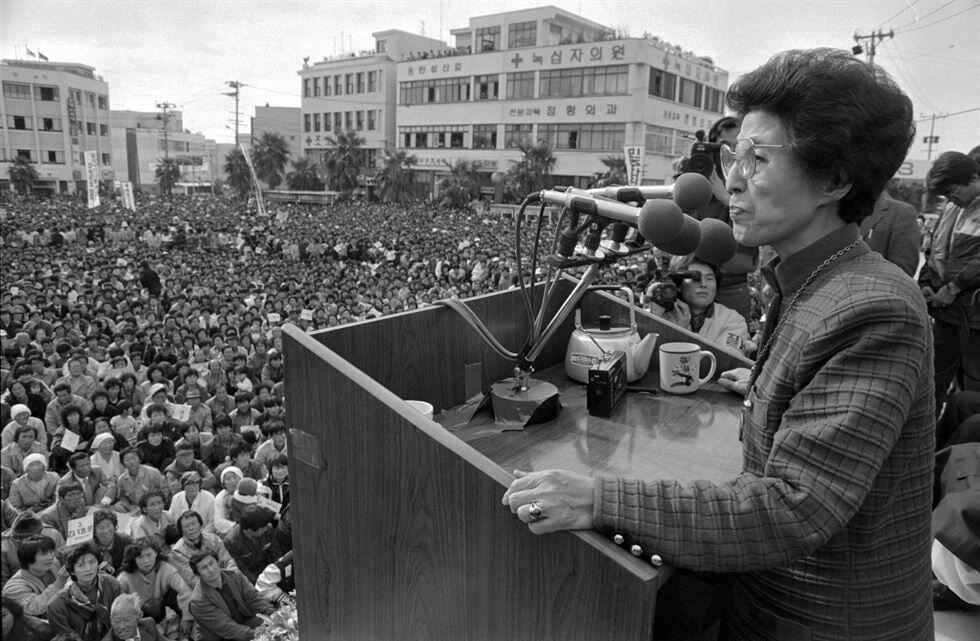
Lee Hee-ho gives a speech during her husband Kim Dae-jung’s campaign for presidential elections. (Source: KoreaTimes)
Their marriage was far more than a personal bond, it was a partnership built on shared conviction and unshakable faith. Lee Hee Ho always stood by Kim Dae Jung through every trial, serving not only as an emotional support but also as a strategic advisor and advocate for his cause. She accompanied him to political events, supported him during his multiple presidential campaigns, and later also played a crucial role in his North Korea policy.
Together, they raised three sons, holding their family together through years filled with danger and uncertainty. Despite the constant surveillance, threats, and exile, their home remained a space of resilience and hope.
Lee Hee-ho’s unwavering support during Kim’s darkest hours—his imprisonments, years in exile, and the looming fear of assassination reflected the depth of their bond and their shared dedication to democracy. This marriage was a story of endurance, faith, and two souls united by a purpose far greater than themselves.
The Struggle Against Authoritarianism
Kim’s emergence as a national political figure came with his selection as the New Democratic Party’s presidential candidate in 1971.
He went head on against the incumbent Park Chung Hee, Kim mounted a vigorous campaign that captivated the nation with his vision of democracy and economic justice.
Despite all the obstacles like election fraud and intimidation by the ruling party, Kim Dae Jung garnered an impressive 46% of votes!
This campaign gave him the spotlight for his exceptional political skills and his ability to connect with ordinary citizens. He advocated for a “mass economy” that would benefit working people rather than just the wealthy elite, and he proposed innovative diplomatic solutions including security guarantees from the four major regional powers: the United States, Soviet Union, People’s Republic of China, and Japan.
The First Assasination Attempt: A Fight Against Tyranny
Just one month after the election, Kim experienced the first of what would be at least five assassination attempts on his life.The assassination attempt failed, but it killed two of his aides and left Kim with a permanent limp, a physical scar he would carry for the rest of his life as a reminder.
The Yushin Era and International Advocacy
In 1972, Kim’s prophecy came true. President Park declared martial law and pushed through the Yushin Constitution, effectively giving himself absolute power. While many were silenced, Kim refused to back down. Taking his fight abroad to Japan and the United States, he became the regime’s most vocal critic on the world stage.
The Korean Central Intelligence Agency (KCIA) saw him as a major threat, and they were right to be worried. Kim skillfully built a network of international supporters, and major American newspapers began exposing the tyranny of the Yushin system.
The Tokyo Kidnapping: A Brush with Death
The most dramatic and dangerous episode in Kim’s struggle against authoritarianism occurred on August 8, 1973, when KCIA agents kidnapped him from his hotel room in Tokyo. Their plan was simple and final: “eliminate” him. On a ship bound for Korea, they tied concrete blocks to his body, preparing to throw him into the ocean.
Kim later described this terrifying experience in deeply personal terms, crediting his Christian faith with saving his life. In his Nobel Prize acceptance speech, he recounted how Jesus Christ appeared to him “with such clarity” just as his captors were about to kill him.
Just at that moment, an airplane appeared as the result of swift intervention by the U.S. Ambassador Philip Habib, who had demanded Kim’s safe return.
The kidnapping created an international incident, with both Japan and the United States condemning the action and demanding Kim’s release. The incident demonstrated both the regime’s determination to silence Kim and the international community’s growing concern about South Korea’s human rights record. Kim was released in Seoul a week later but immediately placed under house arrest.
The Democracy Movement and Continued Persecution
Even under lock and key, Kim’s fight never stopped. In 1976, he co-authored the “Independence Day Declaration for Democratization,” a document that sparked a new wave of pro-democracy protests across the nation. For this act of defiance, he was thrown back in prison for another five years.
After President Park’s assassination in 1979, a flicker of hope emerged, but it was quickly extinguished as a new military general, Chun Doo Hwan, seized power in 1980. Looking for a scapegoat for a civilian uprising in Gwangju, the regime blamed Kim Dae Jung and, in a sham trial, sentenced him to death.
The sentence was first commuted to life imprisonment, then reduced to a 20-year term. Finally, in December 1982, Kim’s prison term was suspended on the condition that he travel to the United States for “medical treatment” which was basically forcing him into exile.
Exile and International Recognition
Despite all the harsh turns of events, This event of exile actually turned out to be a blessing in disguise for him. Why? Keep on reading.
Harvard Years and Intellectual Development
Kim’s exile in the United States from 1982 to 1985 proved to be a transformative period. He served as a fellow at Harvard University’s Center for International Affairs from 1983 to 1984, where he brushed up on his English, deepened his intellectual understanding of democratic theory and economic policy, and cultivated influential American friends. During this period, he published two books and gave numerous speeches to Korean communities across the United States, maintaining his visibility and influence.
The Harvard experience allowed Kim to develop a more sophisticated understanding of international relations and economic policy that would serve him well during his presidency. He studied the experiences of other democratic transitions and developed his ideas about reconciliation and forgiveness that would later influence his approach to North Korea. His time at Harvard also expanded his international network, creating relationships that would prove valuable throughout his later political career.
Return from Exile
In February 1985, despite warnings from supporters that he might face the same fate as Philippine Senator Benigno Aquino, Kim returned to Seoul. As soon as he stepped off the plane, Korean security officers knocked him down and dragged him into house arrest. However, his return immediately intensified the nationwide pro-democracy movement, inspiring thousands of Koreans who saw in his courage a symbol of resistance to authoritarian rule.
The timing of Kim’s return was perfect. South Korea was experiencing growing domestic pressure for democratization, and the international community was increasingly critical of the Chun regime’s human rights record. In June 1987, Kim was cleared of all outstanding charges and had his civil and political rights fully restored. This legal vindication marked the end of nearly two decades of persecution and positioned him for a return to active politics.
Presidential Campaigns and Democratic Transition
Kim ran for president in 1987 and 1992, he lost both the elections but was able to establish himself as the leading voice of the democratic opposition.
After his 1992 defeat to Kim Young Sam, he announced his retirement from politics, but three years later he formed a new political party, the National Congress for New Politics, signaling his determination to continue the fight for democratic reform.
His persistence finally paid off in December 1997, when he was elected president with 40.3 percent of the vote. His victory marked a historic milestone as it was the first transition of power from the ruling party to the opposition in South Korea’s modern history. At age 73, Kim had finally achieved his lifelong goal of leading his nation, but he faced the immediate challenge of an unprecedented economic crisis.
Managing the Asian Financial Crisis
When Kim Dae-jung took office in February 1998, South Korea was standing on the edge of economic collapse which was the worst crisis since the Korean War. The nation had just accepted a $58 billion bailout from the International Monetary Fund (IMF), and fear rippled through every layer of society. Factories were shutting down, unemployment was soaring, and public confidence had nearly vanished.
Even before his inauguration, Kim showcased what true leadership looks like in times of turmoil. He joined hands with outgoing President Kim Young-sam to form a Joint Economic Committee, ensuring a smooth transition and a united front to rescue the economy.
Once in power, Kim wasted no time.He floated the won, liberalized the bond market, raised interest rate caps to 40 percent, and negotiated directly with labor unions to make tough but necessary compromises. Under his leadership, corporations were required to undergo proper audits and take loans publicly which marked the end of secret, backdoor dealings that had plagued the nation’s economy.
He also opened the doors to foreign investment, allowing international buyers to acquire entire companies if they wished, which was a move that shocked traditionalists but injected much-needed vitality into South Korea’s financial system.
Working alongside international advisors, including George Soros, Kim implemented the IMF’s complex recovery plan with remarkable precision. The government recapitalized banks, created public asset management companies to absorb bad loans, and began restructuring the chaebol (the massive business conglomerates) without letting them collapse.
By the early 2000s, most foreign exchange controls were lifted, and a $1.2 billion investment fund was set up to support small and medium-sized enterprises—the lifeblood of the economy.
Against all odds, Kim Dae Jung’s vision worked. South Korea not only avoided bankruptcy but rebounded with stunning speed, becoming a model of post-crisis recovery admired around the world. His ability to bring together unions, corporations, and government institutions each with conflicting interests proved the depth of his political wisdom and the strength of his character.
The Sunshine Policy: A Vision for Peace
Kim’s most significant and controversial policy initiative was the “Sunshine Policy” toward North Korea, formally announced in 1998. The policy’s name was derived from Aesop’s fable “The North Wind and the Sun,” reflecting Kim’s belief that warmth and engagement would be more effective than confrontation in changing North Korean behavior. The policy marked a dramatic departure from the containment and confrontation that had characterized inter-Korean relations since the Korean War.
Origins and Philosophy
The Sunshine Policy was based on three fundamental principles:
- No armed provocation by North Korea would be tolerated
- South Korea would not attempt to absorb North Korea
- South Korea would actively seek cooperation with the North
For decades, the two Koreas had been locked in a cold, hostile standoff. Kim believed it was time to try a different way: engagement and cooperation instead of confrontation.
Kim’s approach was influenced by West Germany’s successful Ostpolitik toward East Germany, which had led to eventual reunification through gradual engagement rather than confrontation. He advocated for the separation of politics and economics, believing that increased economic cooperation could create momentum for political reconciliation.
The Sunshine Policy aimed to reduce tensions, promote humanitarian exchanges, and lay the groundwork for eventual peaceful reunification
The Historic 2000 Summit
The high point of this policy came in June 2000, when the world watched, holding its breath, as Kim Dae-jung flew to Pyongyang to meet North Korean leader Kim Jong Il.

The images of the two leaders embracing were historic, signaling a thaw in the world’s last Cold War frontier.
The summit achieved several concrete results like family reunifications were arranged for people separated since the Korean War, economic cooperation projects were initiated, and cultural exchanges were expanded. The Kaesong Industrial Region was established, where 53,000 North Koreans and 800 South Koreans worked together. Tourist programs allowed more than 1.5 million South Koreans to visit North Korea’s Diamond Mountains over the following years.
International Recognition and the Nobel Prize
Kim Dae Jung’s peace efforts earned him the Nobel Peace Prize in October 2000, making him South Korea’s only Nobel laureate. It was global recognition for a man who had faced down assassins, dictators, and a death sentence to bring freedom and hope to his people.
The Nobel Committee honored him for his work for democracy and human rights in South Korea and in East Asia in general, and for peace and reconciliation with North Korea in particular. The award recognized both his decades-long struggle for democracy and his innovative approach to inter-Korean relations.
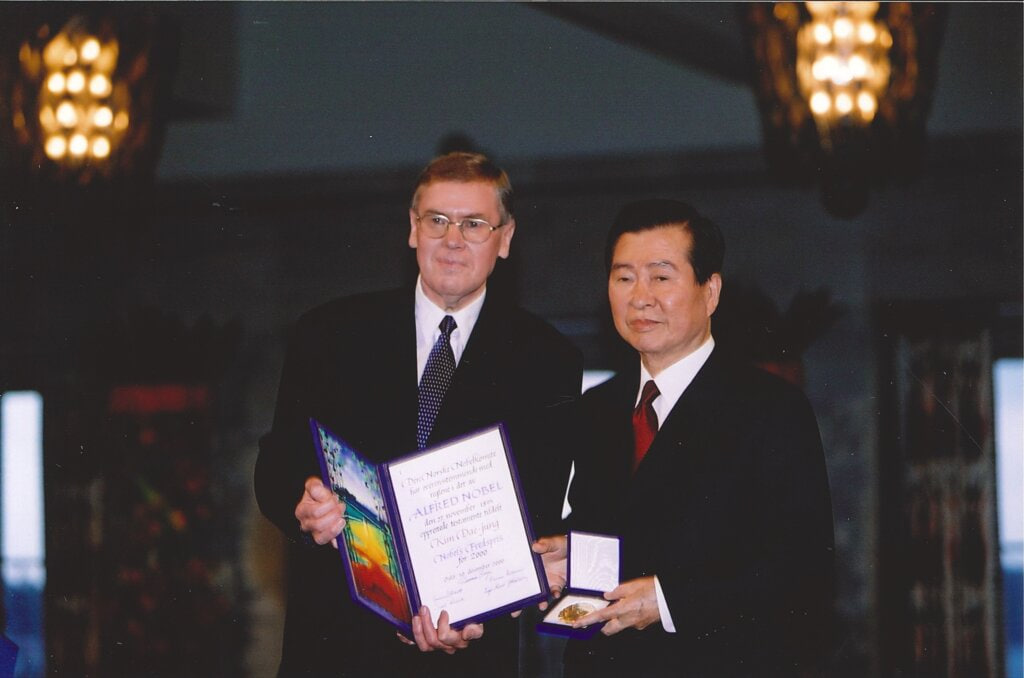
In his Nobel lecture, Kim articulated his vision of democracy as “the absolute value that makes for human dignity, as well as the only road to sustained economic development and social justice”.
He also emphasized that “a national economy lacking a democratic foundation is a castle built on sand,” linking his economic and political philosophies. The Nobel Prize elevated Kim’s international stature and provided him with global validation for his reconciliation efforts.
Challenges and Criticisms of the Sunshine Policy
Despite the achievements, the Sunshine Policy faced significant criticisms and setbacks. Let’s discuss them all in detail here:
The Cash-for-Summit Scandal
The most damaging controversy was the revelation that Hyundai had transferred $500 million to North Korea just months before the 2000 summit, sparking allegations that the government had essentially paid for the meeting. While Hyundai claimed the payment was for business rights, critics argued it was a clear case of North Korea exploiting South Korean goodwill.
Park Jie-won, a key organizer of the summit, was charged with violating foreign exchange and inter-Korean cooperation laws. He was sentenced to three years in prison in 2006 but was later pardoned. The scandal tarnished Kim’s legacy and provided ammunition for conservative critics who argued that engagement with North Korea was naive and counterproductive.
Limited Behavioral Change
While the Sunshine Policy aimed to inspire change through warmth, critics argued that North Korea offered only hostility in return. As South Korea sent aid and opened dialogue, the North continued its aggressive pursuits. It relentlessly developed nuclear weapons and met the policy of peace with acts of war, most notably the 2002 naval attack that left six South Korean sailors dead.
A 2010 South Korean government report delivered a harsh verdict, concluding the policy had failed to produce any “positive changes.” There were also growing fears that South Korea’s goodwill was being exploited. Many believed that financial support intended for starving citizens was instead bankrolling the North’s military ambitions.
Furthermore, the policy created a rift with South Korea’s most important ally. In a post-9/11 world, the Bush administration adopted a hardline stance, viewing Seoul’s engagement as a move that weakened international sanctions and complicated efforts to halt the nuclear crisis. The Sunshine Policy, designed to foster peace, was now accused of weakening the very alliance that guaranteed South Korea’s security.
Domestic Policy Divisions
The Sunshine Policy also contributed to significant domestic political polarization in South Korea. The initial public support for the policy was around 87% of South Koreans in August 2000, but that soon dropped to only 34%by June 2001. The policy created social and political cleavages, with conservatives viewing it as naive appeasement and progressives seeing it as a necessary step toward peace.
The policy’s emphasis on engagement also reduced South Koreans’ perception of the North Korean threat, leading some to question the continued need for the U.S.-South Korea alliance. This “sunshine fatigue” was exploited by conservative politicians who argued for a tougher approach to North Korea.
A Legacy of Fortitude
Everything apart, Kim Dae Jung’s impact on South Korean democracy cannot be overstated. His decades-long struggle against authoritarianism helped establish South Korea as a vibrant democracy, and his eventual election as president demonstrated that peaceful transitions of power were possible.
Often called “the Nelson Mandela of Asia,” Kim showed that reconciliation and democratic governance could triumph over hatred and division.
Yet, his legacy remains complex. His reputation was tarnished not only by the summit controversy but also by corruption scandals involving his sons and his “sometimes dictatorial performance as president”, a criticism suggesting that in his drive to enact sweeping reforms, he occasionally mirrored the top-down authority he had long fought against.
As some observers argue, “he was happier and more effective as an opposition leader than as a democratic leader.” This observation captures the core challenge faced by many revolutionary figures: the skills required to be a symbol of moral opposition “unyielding and idealistic” are often at odds with the pragmatic, compromising nature of governing a complex nation.
Pursuit of Life: Finding the Meaning
Kim Dae-jung’s contributions to uplifting South Korea to democracy are truly remarkable. As we ascend the ladder of Maslow’s hierarchy, we inevitably begin to ponder the deeper questions of life.
At some point, we’ve all wondered why some are born into the harshest conditions—facing adversity every single day just to meet their basic physiological needs, while others enter the world blessed with abundance and comfort in first-world nations.
You might ask yourself, why is there such asymmetry in this world? If there truly is a God above, why does He allow such cruelty and unfairness to persist?
And the chain of questions never really ends.
This is where Saint Rampal Ji Maharaj steps in—with his divine spiritual wisdom, illuminating answers to these timeless mysteries of life and death. He guides humanity toward the true path of worshipping the Almighty, a path firmly rooted in the teachings of our holy scriptures.
His contributions to mankind don’t stop here. He is also leading several humanitarian programs, such as the AnnaPurna Muhim, which aims to support underprivileged people by building homes and providing them with the basic necessities of life until their financial conditions improve. Sant Rampal Ji Maharaj has invested millions of dollars into this initiative, dedicated to uplifting the weak and aiding those in need—whether it’s supplying food to flood-affected villages or providing pipes and motors to help drain water.
Apart from this, he actively promotes moral and ethical values, striving to eliminate the materialistic social structure that brings nothing but misery. His vision is to create a new environment where everyone lives in love, peace, and harmony under the grace of the Almighty.
Saint Rampal Ji is the very revolutionary saint foretold in the prophecies of Nostradamus and many others—a bringer of light in an age overshadowed by despair. He is bringing light to a world where humanity is losing hope, where technology is advancing rapidly, people are growing distant from one another, and empathy is fading, leading civilization toward its decline.
FAQs
1. Who was Kim Dae Jung?
Kim Dae Jung was a South Korean politician who served as the 8th President of South Korea from 1998 to 2003. He was a lifelong democracy advocate and was awarded the Nobel Peace Prize in 2000 for his work on human rights and reconciliation with North Korea.
2. Why was Kim Dae Jung called the “Nelson Mandela of Asia”?
He earned this title for his decades-long, resilient struggle against South Korea’s authoritarian military regimes. Like Mandela, he endured long periods of imprisonment, house arrest, and persecution before eventually becoming president and leading his nation toward democracy.
3. What was the Sunshine Policy?
The Sunshine Policy was Kim Dae Jung’s signature foreign policy initiative toward North Korea. It was based on the idea that engagement, cooperation, and economic assistance would be more effective in reducing tensions and promoting peace than confrontation.
4. Why was Kim Dae Jung kidnapped in 1973?
While in exile in Japan, Kim Dae Jung was a vocal critic of South Korea’s authoritarian government under Park Chung Hee. Agents from the Korean Central Intelligence Agency (KCIA) kidnapped him from his Tokyo hotel room with the intent to assassinate him, but international intervention saved his life.
5. Why did Kim Dae Jung win the Nobel Peace Prize?
He was awarded the Nobel Peace Prize in 2000 for two primary reasons: his lifelong work to establish democracy and human rights in South Korea, and his “Sunshine Policy” efforts to achieve peace and reconciliation with North Korea, highlighted by the historic 2000 inter-Korean summit.


